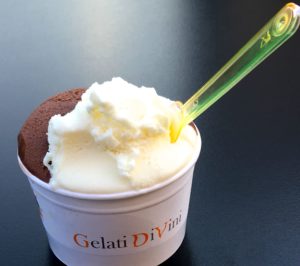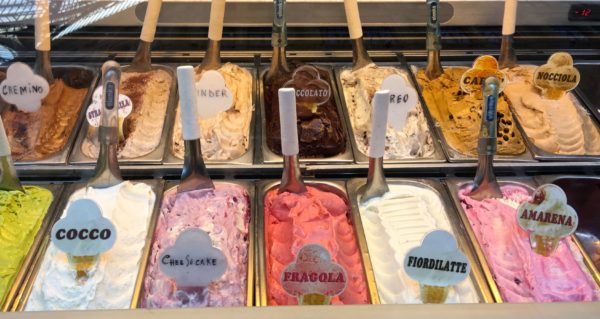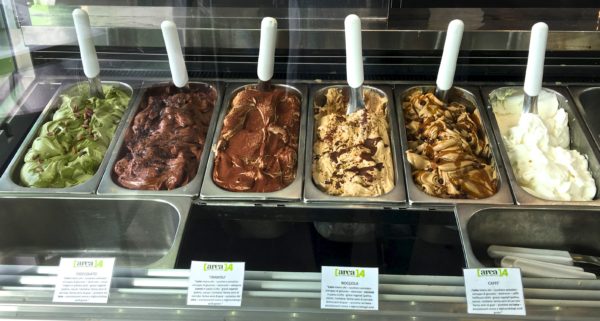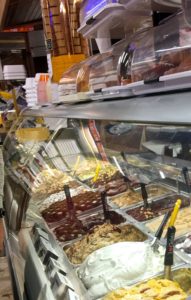
“So… Italian gelato. Take the deliciousness of a regular ice-cream cone, times it by a million, then sprinkle it with crushed-up unicorn horns.” (Jenna Evans Welch, Love & Gelato)
Gelato. Just thinking about it causes me to break out in a smile. Italy’s lighter—and tastier—version of ice cream is worth a trip to the boot-shaped country. Sure, there’s much to be said for pasta, pizza, and wine, but keeping a growing list of all the gelato flavors I’ve tried serves as a diary. I record where I was and what I was doing that day…and how the gelato made everything even more memorable.

On a recent trip to Sicily, I picked up right where I’d left off after my last visit to Rome. For three days, I wandered the streets of Palermo, popping into a gelateria and choosing whichever gelati caught my eye. Hazelnut (nocciola) and strawberry (fragola) after a morning at the Mercato di Ballarò. A single scoop of lemon (limone) on my way to Teatro Massimo. Stopping after visiting the extraordinary Cappella Palatina for the daring combo of almond (mandorla) and cantaloupe (melone).

Then I met Tommaso Pantè (http://www.sunway.it), a Licensed Tour Guide and International Tour Manager based in Sicily. It turns out that I was making mistakes when ordering. After telling us that pistachio (pistacchio) is the national flavor of Sicily, Tommaso was quick to offer advice on how to order gelato like a true Italian:
- One scoop is never enough. It takes two scoops to make an order, three scoops if you’re up for it. After making your order, the server may even ask, “Panna?” to find out if you want whipped cream on top. “This is no time to skimp!” Tommaso declares.
- “No self-respecting Italian” combines a creamy gelato flavor with a fruity one. In fact, cream-based gelati (made with whole milk) is in a separate area of the case from the sorbetti (made with fruit, water, and sugar). For example, it’s fine to order chocolate (cioccolato) and coffee (caffè) together, but not chocolate and pineapple (pesca).
- Servers take pride in their scooping talent. Let them show off. Don’t say “basta” or “enough.” The shop may also like to offer customers a certain amount. Accept your cup (coppa) or cone (cono) with happy gratitude: “Grazie!”
For those of us who have been blissfully ordering gelato without guidance, or still want to order whatever we fancy, Tommaso assures us that all is well. In fact, we can keep doing it. “You’re a tourist,” he explains. “They will forgive you. But I could never get away with that!”

“Gelato tastes a lot like ice cream, but it’s just better for some reason.” (Winston Churchill)
Whether or not you agree with Churchill’s opinion, the two frozen treats aren’t the same. Exactly why does gelato taste so different from ice cream? This is a great question. Let’s compare them:
- Gelato is churned more slowly than ice cream, so less air is mixed in. With only 20-30% air, it’s more dense, silky, and creamy. Ice cream is 50% air, resulting in more volume that makes it soft and fluffy.
- Ice cream is served at 7-12 degrees Fahrenheit, so it can numb the tongue and taste buds. Gelato is best served at 10-15 degrees warmer. Gelato is softer at that temperature, and it also lets flavors emerge more easily.
- Butterfat content is very different between the two. Gelato has more milk than cream, resulting in 4-9% fat. Ice cream legally must have at least 10% butterfat, going as high as 14-25%. This fat coats the palate, dulling the impact of the flavor. I
- Even the serving methods aren’t the same. With its hefty fat content, ice cream is firm, and scoops into a lovely, round ball. Gelato comes out of its pan with a blade or spatula in a soft mound.
- Calorie-wise, it makes sense that gelato wins this comparison. In a typical serving (3.5 ounces) of vanilla gelato, you’ll get 90 calories, 3 grams of fat, and 10 grams of sugar. Vanilla ice cream delivers 125 calories, 7 grams of fat, and 14 grams of sugar.
“Money can’t buy happiness, but it can buy gelato. That’s kind of the same thing…” (Pinterest)

Who can the world thank for the gift of gelato? First, the powerful Medici family of Florence; they were always looking for ways to impress their visitors. When Spanish dignitaries were scheduled for an important visit in the 16th century, Grand Duke of Tuscany, Cosimo I de’ Medici wanted to impress them. It was at his urging that Bernardo Buontalenti, his lifelong architect, stage and theatrical designer, and gourmand, oversee the entire celebration. Buontalenti arranged for fireworks, multiple performances, and the sumptuous banquet. Also an inventor, he designed a whisk and went to work developing the frozen dessert that would ultimately become gelato. He mixed ice with sugar, honey, and milk, then used lemons, oranges, and a splash of wine for flavor…and as they say, the rest is history. Over 500 years later, the world thanks both the patron and the inventor.

Gelato is more than a delicious part of your trip to Italy. It’s a national treasure that Italians enjoy on a daily basis. As Tommaso suggests, don’t hold back. Savor the history and essence of the country by seeking out the local gelateria and trying new flavors. Start your own list.
Buon appetito!
